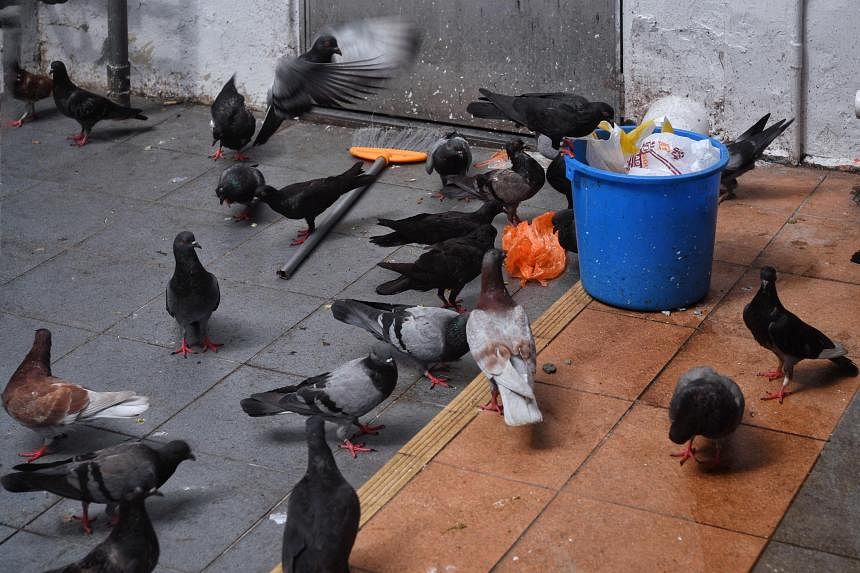SINGAPORE - A range of measures is used to control the population of rock pigeons in Singapore – an invasive species which competes with native pigeons for resources – including tree pruning to remove places to roost, and repellents to discourage the feral bird from landing on buildings.
However, with approximately 190,000 rock pigeons crowding the heartland, population control measures also include culling and poisoning.
These steps are seen as too extreme by some members of the public and animal welfare groups such as the Animal Concerns Research and Education Society (Acres).
On May 22, 30 pigeons, either dead or unconscious, were found on grass patches in Yishun Avenue 11.
Some upset residents contacted Acres and Nee Soon Town Council, which said there had been a “scheduled pigeon treatment” to manage the pigeon population, as it had caused hygiene problems and inconveniences to residents.

In a separate incident, Acres posted a video on its Facebook page in April 2019 of a pigeon-culling exercise outside Hougang MRT station which showed pigeons being stomped on, swept into dustpans, and dumped into trash bags while they were still alive.
The exercise was carried out by contractors sent by Aljunied-Hougang Town Council.
Only companies registered with the National Environment Agency as vector control operators (VCOs) can be engaged to undertake vector control works.
Employees of VCOs must be licensed as vector control technicians or certified as vector control workers to carry out any vector control work.
Mr Ryan Lee, group director of wildlife management at National Parks Board (NParks), told The Straits Times that a science-based approach is employed when managing invasive bird species such as pigeons.
This includes studies to understand the ecology of pest birds, such as their roosting and foraging patterns, removal of human food sources, habitat modification such as targeted tree pruning and planting of appropriate tree species, as well as active population control, including trapping and culling.
Mr Lee added that NParks works with town councils to manage the pigeon population.
“This includes encouraging alternative humane practices for pigeon population management operations like trapping, and encouraging animal management companies to send employees for wildlife management training courses conducted by NParks,” he said.
The courses equip professionals with skills to carry out animal management work, while ensuring public safety, personnel safety and animal welfare, said Mr Lee.
Rock pigeons are not native to Singapore, and are considered an invasive species that competes with local species for resources.
Alternative humane practices for pigeon population management include proper waste management to reduce potential food sources and encouraging the public not to feed the birds.

Under the enhanced Wildlife Act, which was introduced on June 1, 2020, the fine for feeding any wild bird is a sum of up to $10,000.
Mr Lee said that from June 1, 2020, till June 28, 2023, NParks took enforcement actions in relation to more than 200 cases of pigeon feeding. These included issuing warnings and composition fines.
During the same period, NParks received nearly 15,000 pieces of pigeon-related feedback.
Mr Lee said NParks has been working with town councils and other agencies to reduce food sources for pigeons, such as by tackling high-rise littering and managing waste at food establishments and bin centres.
“We have also reached out to the community and schools through public education efforts, to remind the public to refrain from feeding pigeons and to maintain the cleanliness of the environment,” he added.
Pest control companies here utilise a variety of strategies to remove pigeons from urban areas.
These include bird-point deterrents, which are spikes positioned to prevent birds from roosting at a certain place, and bird-gel repellent, a non-toxic gel that creates an uncomfortable surface that discourages birds from landing.
Other methods, which animal welfare groups say cause unnecessary suffering, include poisoning through the use of a drug called alpha-chloralose, which makes the birds lose their ability to control body temperature and overall function.
Pigeons are known to carry salmonella bacteria, which cause one of the most common types of food poisoning, and ornithosis, a disease that can cause fever, headache, muscle aches and cough through infected droppings.
Dr Qian Tang, a postdoctoral research fellow at the National University of Singapore, believes pigeons do not pose as great a health risk as other pests.
“As far as I know, pathogens that are detected in pigeons are not as serious as (those in) rats.
“Most cause some skin or stomach problems. There is no evidence that I know of to show that pigeons can transmit highly infectious diseases,” he said.
Rats are known to cause severe respiratory illnesses such as hantavirus pulmonary syndrome and haemorrhagic fever with renal syndrome, both of which can be fatal.
He said places where high densities of pigeons can be found are usually high-rise buildings, adding that despite not being native to Singapore, rock pigeons cause minimal disruption to the local ecosystem.
The postdoctoral research fellow, who conducted a research project in 2018 on pigeons in Singapore, estimated there are 190,000 rock pigeons here.
While some residents want them gone, Ms Aarthi Sankar, executive director of the Society for the Prevention of Cruelty to Animals, believes there are others who do not see the birds as a nuisance.
“While some people consider pigeons to be pests, others may view them differently and appreciate their presence in urban environments.”
Ms Sankar said methods such as poisoning are “cruel and inhumane”, and added that the sight of dying birds and their disposal in public spaces can be “distressing, particularly for children”.
“By addressing the root causes of population growth and adopting alternative methods, we can achieve more sustainable and compassionate solutions for coexisting with pigeons in urban environments,” she added.


